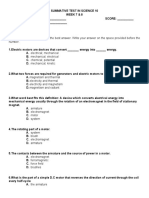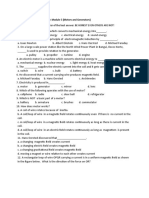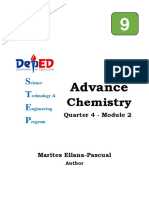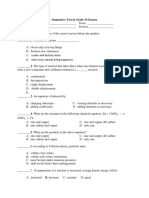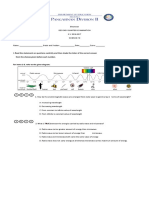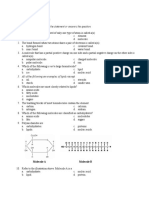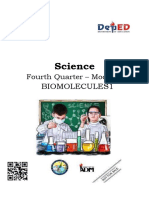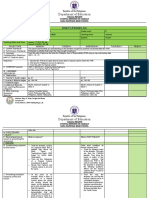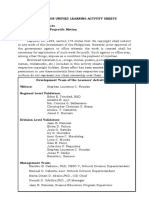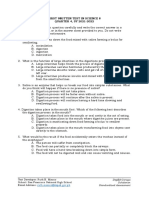Second Written Test in Science 10 QUARTER 4, SY 2021-2022 Instructions: Read Each Question Carefully and Write The Correct Answer in A
Uploaded by
joan marie PeliasSecond Written Test in Science 10 QUARTER 4, SY 2021-2022 Instructions: Read Each Question Carefully and Write The Correct Answer in A
Uploaded by
joan marie PeliasSECOND WRITTEN TEST IN SCIENCE 10
QUARTER 4, SY 2021-2022
Instructions: Read each question carefully and write the correct answer in a
separate sheet of paper, or in the answer sheet provided to you. Do not write anything
on this test questionnaire.
1. Amino acids are the building blocks of which group of biomolecules?
A. lipids
B. proteins
C. nucleic acids
D. carbohydrates
2. Disaccharide is formed by combining two monosaccharides. What do you call the
process of combining two or more simple sugars?
A. Hydrolysis
B. Condensation
C. Peptide bonding
D. Saccharide bonding
3. Which of the following sugars are the components of sucrose?
A. glucose and maltose
B. fructose and glucose
C. maltose and galactose
D. fructose and galactose
4. In which organs are glycogen stored in the body?
A. liver and bile
B. liver and spleen
C. liver and muscle
D. liver and adipose tissue
5. Which of the following is/are the major function(s) of carbohydrates?
I. Storage
II. Energy production
III. Structural framework
A. I only
B. III only
C. I and II only
D. II and III only
Test Developer: Jun Rey M. Meking DepEd-Caraga
School: Agusan del Sur National High School Sukdanan
Email Address: [email protected] Standardized Assessment
6. Nutritional chemists have found that burning 1 gram of fat releases twice the
amount of heat energy as burning 1 gram of starch. Based on this information,
which type of biomolecule would cause a person to gain more weight?
A. fat
B. protein
C. nucleic acid
D. carbohydrate
7. What function do proteins perform when they speed up biological reactions?
A. catalysis
B. movement
C. storage
D. transport
8. Which of the following contains the most lipids?
A. cheese
B. banana
C. olive oil
D. champorado
9. Lipids are insoluble in water because lipid molecules are _____________.
A. hydrophilic
B. hydrophobic
C. neutral
D. zwitterions
10. Junrey wanted to increase his muscle mass while doing work out sessions. In
order to achieve his goal more efficiently, which of the following should he
consider in his diet?
A. eat foods rich in proteins
B. eat more leafy vegetables
C. drink soda after every meal
D. consume more energy drinks
11. Gina loves to eat fried chicken, hamburgers, pork sausages, chips, and French
fries for her day-to-day meals. Which of the following would you predict to be
the outcome of this practice in Gina’s over-all health?
A. Gina will have a very low body mass index (BMI).
B. Gina will be immune to emerging infectious diseases.
C. Gina will have an increased risk of heart disease and stroke.
D. Gina will be very active and energetic in her daily physical activities.
Test Developer: Jun Rey M. Meking DepEd-Caraga
School: Agusan del Sur National High School Sukdanan
Email Address: [email protected] Standardized Assessment
For items 12-13, refer to Figure 1 below.
Figure 1. Sample Nutritional Label
(Source: https://familydoctor.org/wp-content/uploads/2007/10/nutrition-facts-label-148x300.png)
12. Nutrition facts of a product is one of the minimum mandatory information that
should be labelled in all pre-packaged foods. Based on the data given above,
how many calories can you take if you consume the whole contents of this
product?
A. 110 calories
B. 125 calories
C. 250 calories
D. 500 calories
13. Based from the amount of calories per serving and amount of protein indicated
in the sample nutritional label, if each gram of protein is 10 calories, what
percent of the calories comes from the protein?
A. 10 %
B. 20 %
C. 30 %
D. 40 %
Test Developer: Jun Rey M. Meking DepEd-Caraga
School: Agusan del Sur National High School Sukdanan
Email Address: [email protected] Standardized Assessment
14. The curve given below shows enzymatic activity with relation to three conditions
(pH, temperature, and substance concentration). What do the two axes (X and
Y) represent?
Figure 2. Enzyme Activity
(Source:https://haygot.s3.amazonaws.com/questions/663571_1e838e738e1c412fb96f7b82a68caba5.jpg)
X Y
A. Enzymatic Activity - pH Level
B. Enzymatic Activity - Temperature
C. Temperature - Enzymatic Activity
D. Substrate concentration - Enzymatic Activity
15. Carly wanted to determine what types of biomolecules are present in the three
unknown substances that her teacher gave her. The following table shows her
results.
Table 1. Summary of Test Results for the determination of Types of Biomolecules
Substance Iodine Test Biuret Test Benedict’s Test
A Black solution (+) (-) (-)
B (-) (+) (-)
C (-) (-) (+)
(Source: Acosta, Herma, Liza Alvarez, Dave Angeles, Ruby Arre, Ma. Pilar Carmona, Aurelia Garcia, Arlen Gatpo,
Judith Marcaida, Ma. Regaele Olarte, Marivic Rosales, and Nilo Salazar. Science-Grade 10 Learner's Material. 5th
Floor Mabini Building, Deped Complex Meralco Avenue, Pasog City, Philippines, 1600: Department of Education,
2015. )
Which of the following statements is TRUE?
A. Substances A and B are proteins while substance C is a lipid.
B. Substance B is a carbohydrate while substances A and C are lipids.
C. Substance A contains starch and substances B and C contain nucleic
acid.
D. Substances A and C are carbohydrates where A is an amylose in starch,
B is a protein, and C may be a simple sugar.
Test Developer: Jun Rey M. Meking DepEd-Caraga
School: Agusan del Sur National High School Sukdanan
Email Address: [email protected] Standardized Assessment
16. Which of the following is inconsistent with the base pairings in a double
stranded DNA molecule?
A. The ratio of (G-C) to (A-T) is the same for each species.
B. The number of adenine is equal to the number of thymine.
C. The number of cytosine is equal to the number of guanine.
D. The amount of purines is the same with the amount of pyrimidines.
17. The following are true about amino acids EXCEPT
A. They are constituents of all proteins.
B. Alanine having one amino group and one carboxylic group.
C. Most naturally occurring amino acids have D-configuration.
D. Glycine is one of the conditional amino acids like glutamine and tyrosine.
18. Influx of migratory birds in the Philippines starts by September of each year
where they stop briefly along wetlands to rest and hunt for food before
continuing their journey. In order to continue this long-distance travel,
migratory birds store fats as their source of energy instead of carbohydrates and
proteins. Do you think this is a good idea?
A. No. Fatty foods would be difficult to find for migratory birds and will only
cause delay to their long-distance travel.
B. Yes. Intake of unsaturated fats is good for their system to lower their
cholesterol level and maintains their healthy body.
C. No. Storing fats in the body would increase their total weight and
therefore, results to difficulties in flying slowing their migration.
D. Yes. Fats store per gram and produce twice as much energy as
carbohydrates and proteins enabling them to last long distances.
19. Johannes would like to know how his friends always tell him that he looks so
much like his parents. He asked his Chemistry teacher about the reason and
accordingly, it has something to do with biomolecules specifically nucleic acids
and proteins. Based on the situation above, did the teacher answer Johannes’
question correctly?
A. No. Johannes should have asked his biology teacher instead.
B. No. There is no direct link between biomolecules and inheritance of
genetic information from parents to offspring.
C. Yes. Inheritance of traits is directed by how nucleic acids code specific
proteins to be produced however inheritance only happens in the first
generation of offspring.
D. Yes. Nucleic acids are molecules that code for hereditary traits by
controlling sequences of amino acids in the production of proteins for
specific or unique traits.
Test Developer: Jun Rey M. Meking DepEd-Caraga
School: Agusan del Sur National High School Sukdanan
Email Address: [email protected] Standardized Assessment
20. Which of the following would best describe what “lactose intolerance” is?
A. This is where children grow to naturally prefer juice than milk due to the
different processes in its production where enzymes are killed causing an
allergic reaction to children.
B. It is a build-up of lactose in the stomach which mixes with mucus
causing an oxidation reaction. The enzyme lactase dies due to the
reaction which in turn generates heat causing that individual to have a
fever.
C. This is where lactase enzyme used to break down lactose is not sufficient
causing it to accumulate in the stomach. As a result, one will get bloating
effect, abdominal discomfort, and diarrhea.
D. Lactose intolerance is where someone cannot tolerate milk in their
stomach due to a number of foods eaten at the same time. Lactose may
have a negative impact on that person through the milk which may result
to vomiting.
21. Which of the following would you use to support the idea that a cell as a basic
unit of life is comprised almost entirely of four basic types of molecules –
carbohydrates, proteins, lipids, and nucleic acids?
A. All biological molecules are vital for life as it aids organisms to grow,
sustain, and reproduce.
B. Biomolecules are involved in building organisms from single cells to
complex living beings like humans by interacting with each other.
C. Cells are composed of organic compounds with elements oxygen, carbon,
hydrogen, and nitrogen which make up 96% of the human body’s mass.
D. All of the above
22. Jenny ought to run a mile as one of her exercises for her gym class. What kind
of food would you suggest her to take for her breakfast before she begins her
activity?
A. Fatty foods in order to help her body absorb more vitamins such as A, D,
and E.
B. A meal with fruits and vegetables to boost her immune system while
doing her physical activities.
C. Breakfast with high protein content in order to help in building and
repairing muscles and bones that can be damaged after her one-mile run.
D. Carbohydrates-rich meal to provide her body with glucose that will be
converted into energy to support bodily functions and sustain her
physical activity.
Test Developer: Jun Rey M. Meking DepEd-Caraga
School: Agusan del Sur National High School Sukdanan
Email Address: [email protected] Standardized Assessment
23. Health crisis in this Covid-19 pandemic has been the greatest challenge faced
by everyone across the globe. With this, nutrition plays a significant role in
boosting the immune system. As a health advocate, how would you convince
people that carbohydrates, proteins, lipids, and nucleic acids help fight against
Covid-19?
A. Post negative side effects of Covid-19 vaccines in social media platforms
like facebook and tweeter.
B. Publish articles that promote health benefits of daily exercise and zumba.
C. Eat foods rich in biomolecules and show your body to your friends as a
living proof on its good effects.
D. Keep on advising people that a balanced diet of foods rich in
carbohydrates, proteins, lipids, and nucleic acids can guarantee a strong
immune system that can help withstand any assault by the virus.
24. Which of the following can you suggest to someone with lactose intolerance?
A. Limit consumption of dairy products such as milk, cheese, ice cream,
yogurt, and butter.
B. Sustain the body with other foods rich in calcium as alternative to dairy
products like leafy green vegetables, cereals, juices, nuts, etc.
C. Make an appointment to a doctor to discuss about symptoms, medications,
alternatives, and how to maintain good nutrition despite being lactose
intolerant.
D. All of the above
25. If you were to give an advice on fat intake, from what consideration would you
take it as good or bad?
A. Consumption of fatty foods do not have good effects in your body.
B. Eat fatty foods in high amounts and observe its effects in the body.
C. It depends in you whether your intake of fatty foods is in moderation or
not.
D. Better avoid the consumption of fatty foods as this has neither good nor
bad effects in the body.
Test Developer: Jun Rey M. Meking DepEd-Caraga
School: Agusan del Sur National High School Sukdanan
Email Address: [email protected] Standardized Assessment
You might also like
- Hourglass Workout Program by Luisagiuliet 276% (21)Hourglass Workout Program by Luisagiuliet 251 pages
- The Hold Me Tight Workbook - Dr. Sue Johnson100% (16)The Hold Me Tight Workbook - Dr. Sue Johnson187 pages
- Read People Like A Book by Patrick King-Edited62% (66)Read People Like A Book by Patrick King-Edited12 pages
- Livingood, Blake - Livingood Daily Your 21-Day Guide To Experience Real Health77% (13)Livingood, Blake - Livingood Daily Your 21-Day Guide To Experience Real Health260 pages
- COSMIC CONSCIOUSNESS OF HUMANITY - PROBLEMS OF NEW COSMOGONY (V.P.Kaznacheev,. Л. V. Trofimov.)94% (212)COSMIC CONSCIOUSNESS OF HUMANITY - PROBLEMS OF NEW COSMOGONY (V.P.Kaznacheev,. Л. V. Trofimov.)212 pages
- Donald Trump & Jeffrey Epstein Rape Lawsuit and Affidavits83% (1016)Donald Trump & Jeffrey Epstein Rape Lawsuit and Affidavits13 pages
- The 36 Questions That Lead To Love - The New York Times94% (34)The 36 Questions That Lead To Love - The New York Times3 pages
- The 36 Questions That Lead To Love - The New York Times95% (21)The 36 Questions That Lead To Love - The New York Times3 pages
- Jeffrey Epstein39s Little Black Book Unredacted PDF75% (12)Jeffrey Epstein39s Little Black Book Unredacted PDF95 pages
- The 4 Hour Workweek, Expanded and Updated by Timothy Ferriss - Excerpt23% (954)The 4 Hour Workweek, Expanded and Updated by Timothy Ferriss - Excerpt38 pages
- Department of Education: Learning Activity SheetNo ratings yetDepartment of Education: Learning Activity Sheet7 pages
- Second Quarter Periodical Test - Electronics100% (1)Second Quarter Periodical Test - Electronics3 pages
- Third Written Test in Science 10 QUARTER 4, SY 2021-2022No ratings yetThird Written Test in Science 10 QUARTER 4, SY 2021-20225 pages
- Third Written Test in Science 9 QUARTER 4, SY 2021-2022: ST ND RDNo ratings yetThird Written Test in Science 9 QUARTER 4, SY 2021-2022: ST ND RD6 pages
- Department of Education: Republic of The PhilippinesNo ratings yetDepartment of Education: Republic of The Philippines7 pages
- Learning Activity Worksheet (LAW) : Q4-Science 10No ratings yetLearning Activity Worksheet (LAW) : Q4-Science 108 pages
- Feedback Mechanisms Involved in Regulating Processes in The Female Reproductive SystemNo ratings yetFeedback Mechanisms Involved in Regulating Processes in The Female Reproductive System11 pages
- MIDTERM EXAMINATION in GENERAL PHYSICS 1.finalNo ratings yetMIDTERM EXAMINATION in GENERAL PHYSICS 1.final12 pages
- Qualitative Characteristics of Images: Absorbed Reflection Scatters Transmitted100% (1)Qualitative Characteristics of Images: Absorbed Reflection Scatters Transmitted6 pages
- Test Bank for Nutrition For A Changing World, 2nd Edition, Jamie Pope, Steven Nizielskiinstant download100% (4)Test Bank for Nutrition For A Changing World, 2nd Edition, Jamie Pope, Steven Nizielskiinstant download48 pages
- Immediate download Test Bank for Nutrition For A Changing World, 2nd Edition, Jamie Pope, Steven Nizielski all chapters100% (7)Immediate download Test Bank for Nutrition For A Changing World, 2nd Edition, Jamie Pope, Steven Nizielski all chapters37 pages
- Daily Attendance For Limited Face To FaceNo ratings yetDaily Attendance For Limited Face To Face2 pages
- Science-Grade 9 Learner Activity Sheets Quarter 4-Week 4: Impulse and Momentum First Edition, 2021100% (4)Science-Grade 9 Learner Activity Sheets Quarter 4-Week 4: Impulse and Momentum First Edition, 202115 pages
- Second Written Test in Science 9 QUARTER 4, SY 2021-2022100% (1)Second Written Test in Science 9 QUARTER 4, SY 2021-20225 pages
- Name: Score: Grade & Section: Date:: First Written Test in Science 8 QUARTER 4, SY 2021-2022No ratings yetName: Score: Grade & Section: Date:: First Written Test in Science 8 QUARTER 4, SY 2021-20223 pages
- Second Written Test in Science 9 QUARTER 4, SY 2021-2022No ratings yetSecond Written Test in Science 9 QUARTER 4, SY 2021-20225 pages
- Fourth Written Test in Science 10 QUARTER 4, SY 2021-2022 Instructions: Read Each Question Carefully and Write The Correct Answer in A0% (1)Fourth Written Test in Science 10 QUARTER 4, SY 2021-2022 Instructions: Read Each Question Carefully and Write The Correct Answer in A4 pages
- Fourth Written Test in Science 9 QUARTER 4, SY 2021-2022100% (1)Fourth Written Test in Science 9 QUARTER 4, SY 2021-20226 pages
- First Written Test in Science 10 QUARTER 4, SY 2021-2022 Instructions: Read Each Question Carefully and Write The Correct Answer in A100% (3)First Written Test in Science 10 QUARTER 4, SY 2021-2022 Instructions: Read Each Question Carefully and Write The Correct Answer in A5 pages
- Third Written Test in Science 8 QUARTER 4, SY 2021-2022 Instructions: Read Each Question Carefully and Write The Correct Answer in ANo ratings yetThird Written Test in Science 8 QUARTER 4, SY 2021-2022 Instructions: Read Each Question Carefully and Write The Correct Answer in A5 pages
- First Written Test in Science 9 QUARTER 4, SY 2021-20220% (1)First Written Test in Science 9 QUARTER 4, SY 2021-20227 pages
- Second Written Test in Science 8 QUARTER 4, SY 2021-2022 Instructions: Read Each Question Carefully and Write The Correct Answer in ANo ratings yetSecond Written Test in Science 8 QUARTER 4, SY 2021-2022 Instructions: Read Each Question Carefully and Write The Correct Answer in A5 pages
- Printed in The Philippines by Department of Education - Schools Division of Surigao Del NorteNo ratings yetPrinted in The Philippines by Department of Education - Schools Division of Surigao Del Norte11 pages
- First Written Test in Science 8 QUARTER 4, SY 2021-2022 Instructions: Read Each Question Carefully and Write The Correct Answer in A100% (2)First Written Test in Science 8 QUARTER 4, SY 2021-2022 Instructions: Read Each Question Carefully and Write The Correct Answer in A5 pages
- Fourth Written Test in Science 8 QUARTER 4, SY 2021-2022 Instructions: Read Each Question Carefully and Write The Correct Answer in ANo ratings yetFourth Written Test in Science 8 QUARTER 4, SY 2021-2022 Instructions: Read Each Question Carefully and Write The Correct Answer in A5 pages
- Be Necessary For Exploitation of Such Work For Profit."No ratings yetBe Necessary For Exploitation of Such Work For Profit."10 pages
- Gaudete Et Exsultate Apostolic Exhortation Pope Francis in English0% (1)Gaudete Et Exsultate Apostolic Exhortation Pope Francis in English47 pages
- Livingood, Blake - Livingood Daily Your 21-Day Guide To Experience Real HealthLivingood, Blake - Livingood Daily Your 21-Day Guide To Experience Real Health
- COSMIC CONSCIOUSNESS OF HUMANITY - PROBLEMS OF NEW COSMOGONY (V.P.Kaznacheev,. Л. V. Trofimov.)COSMIC CONSCIOUSNESS OF HUMANITY - PROBLEMS OF NEW COSMOGONY (V.P.Kaznacheev,. Л. V. Trofimov.)
- Donald Trump & Jeffrey Epstein Rape Lawsuit and AffidavitsDonald Trump & Jeffrey Epstein Rape Lawsuit and Affidavits
- The 36 Questions That Lead To Love - The New York TimesThe 36 Questions That Lead To Love - The New York Times
- The 36 Questions That Lead To Love - The New York TimesThe 36 Questions That Lead To Love - The New York Times
- Jeffrey Epstein39s Little Black Book Unredacted PDFJeffrey Epstein39s Little Black Book Unredacted PDF
- The 4 Hour Workweek, Expanded and Updated by Timothy Ferriss - ExcerptThe 4 Hour Workweek, Expanded and Updated by Timothy Ferriss - Excerpt
- Third Written Test in Science 10 QUARTER 4, SY 2021-2022Third Written Test in Science 10 QUARTER 4, SY 2021-2022
- Third Written Test in Science 9 QUARTER 4, SY 2021-2022: ST ND RDThird Written Test in Science 9 QUARTER 4, SY 2021-2022: ST ND RD
- Department of Education: Republic of The PhilippinesDepartment of Education: Republic of The Philippines
- Feedback Mechanisms Involved in Regulating Processes in The Female Reproductive SystemFeedback Mechanisms Involved in Regulating Processes in The Female Reproductive System
- Qualitative Characteristics of Images: Absorbed Reflection Scatters TransmittedQualitative Characteristics of Images: Absorbed Reflection Scatters Transmitted
- Test Bank for Nutrition For A Changing World, 2nd Edition, Jamie Pope, Steven Nizielskiinstant downloadTest Bank for Nutrition For A Changing World, 2nd Edition, Jamie Pope, Steven Nizielskiinstant download
- Immediate download Test Bank for Nutrition For A Changing World, 2nd Edition, Jamie Pope, Steven Nizielski all chaptersImmediate download Test Bank for Nutrition For A Changing World, 2nd Edition, Jamie Pope, Steven Nizielski all chapters
- Science-Grade 9 Learner Activity Sheets Quarter 4-Week 4: Impulse and Momentum First Edition, 2021Science-Grade 9 Learner Activity Sheets Quarter 4-Week 4: Impulse and Momentum First Edition, 2021
- Second Written Test in Science 9 QUARTER 4, SY 2021-2022Second Written Test in Science 9 QUARTER 4, SY 2021-2022
- Name: Score: Grade & Section: Date:: First Written Test in Science 8 QUARTER 4, SY 2021-2022Name: Score: Grade & Section: Date:: First Written Test in Science 8 QUARTER 4, SY 2021-2022
- Second Written Test in Science 9 QUARTER 4, SY 2021-2022Second Written Test in Science 9 QUARTER 4, SY 2021-2022
- Fourth Written Test in Science 10 QUARTER 4, SY 2021-2022 Instructions: Read Each Question Carefully and Write The Correct Answer in AFourth Written Test in Science 10 QUARTER 4, SY 2021-2022 Instructions: Read Each Question Carefully and Write The Correct Answer in A
- Fourth Written Test in Science 9 QUARTER 4, SY 2021-2022Fourth Written Test in Science 9 QUARTER 4, SY 2021-2022
- First Written Test in Science 10 QUARTER 4, SY 2021-2022 Instructions: Read Each Question Carefully and Write The Correct Answer in AFirst Written Test in Science 10 QUARTER 4, SY 2021-2022 Instructions: Read Each Question Carefully and Write The Correct Answer in A
- Third Written Test in Science 8 QUARTER 4, SY 2021-2022 Instructions: Read Each Question Carefully and Write The Correct Answer in AThird Written Test in Science 8 QUARTER 4, SY 2021-2022 Instructions: Read Each Question Carefully and Write The Correct Answer in A
- First Written Test in Science 9 QUARTER 4, SY 2021-2022First Written Test in Science 9 QUARTER 4, SY 2021-2022
- Second Written Test in Science 8 QUARTER 4, SY 2021-2022 Instructions: Read Each Question Carefully and Write The Correct Answer in ASecond Written Test in Science 8 QUARTER 4, SY 2021-2022 Instructions: Read Each Question Carefully and Write The Correct Answer in A
- Printed in The Philippines by Department of Education - Schools Division of Surigao Del NortePrinted in The Philippines by Department of Education - Schools Division of Surigao Del Norte
- First Written Test in Science 8 QUARTER 4, SY 2021-2022 Instructions: Read Each Question Carefully and Write The Correct Answer in AFirst Written Test in Science 8 QUARTER 4, SY 2021-2022 Instructions: Read Each Question Carefully and Write The Correct Answer in A
- Fourth Written Test in Science 8 QUARTER 4, SY 2021-2022 Instructions: Read Each Question Carefully and Write The Correct Answer in AFourth Written Test in Science 8 QUARTER 4, SY 2021-2022 Instructions: Read Each Question Carefully and Write The Correct Answer in A
- Be Necessary For Exploitation of Such Work For Profit."Be Necessary For Exploitation of Such Work For Profit."
- Gaudete Et Exsultate Apostolic Exhortation Pope Francis in EnglishGaudete Et Exsultate Apostolic Exhortation Pope Francis in English




































